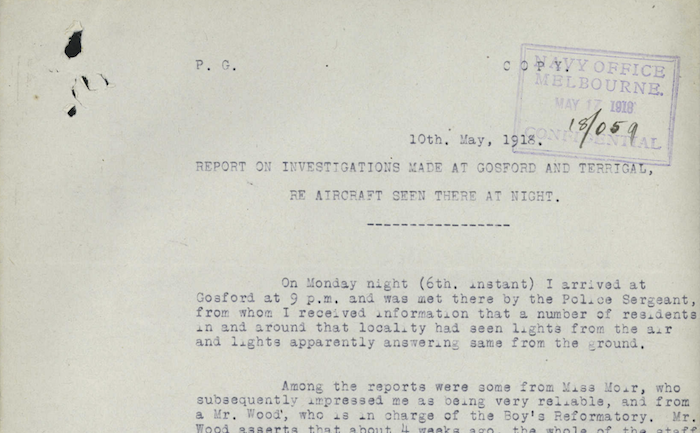
NAA: MP1049/1, 1918/066, page 878, is a report submitted by Constable J. Wright of Ouyen police station, in the Mallee region of northwestern Victoria:
I have to report that whilst I was in the vicinity of Nyang about thirty miles from Ouyen at 4 30 pm on 21.3.18 I saw two flying machines pass overhead. They were up an [sic] great height & appeared to be about twenty yards apart. I did not hear the noise of the machines. They proceeded in a Westerly direction & as the sky was particularly clear, the machines were easily discernible.
And that's all Wright wrote. His superiors forwarded his report down to Melbourne, where, three days later, it was received at the Navy Office. There, Lieutenant-Commander J. G. Latham, a former lawyer (and future chief justice) who was head of naval intelligence, read it and commented: 'Reads true'.
In my article, I use this report to mark the effective start of the panic. There were some mystery aeroplane sightings earlier in the month, albeit overseas in Papua and in New Zealand earlier in the month. But none of these attracted the official and press attention that Wright's sighting did. The reason seems clear to me. Wright's sighting took place on the same day as the German army launched a massive offensive on the Western Front, its last-ditch attempt to win the war before the Americans could make a difference -- in fact, allowing for the difference in time zones, it must have been at almost the exact same time as the German bombardment. Of course, Wright didn't know that, but if he was paying any attention at all he would have an idea that a big German attack was imminent: the press had been freely speculating for weeks about the upcoming German offensive, along with its possible location and timing. For example, the Melbourne Argus, one of the major papers in the capital, ran an article the Saturday before the encounter at Nyang with the headline 'THE COMING OFFENSIVE'. And on the same page was a story that a seaplane from the German raider Wolf had actually flown over Sydney Harbour the previous year. Even more sensationistically, the Monday edition of Melbourne Herald asked 'WAS HUN RAIDER'S SEAPLANE OVER VICTORIAN BUSHLAND?' The answer was of course 'no', but the Herald's readers didn't know that. Was Wright one of those readers? There's no indication that he was, but Ouyen was on the railway line to Melbourne and would have got all the major papers in a timely fashion. Even if he didn't read the story directly, he still might have heard of it by word of mouth. A month ago, seeing something in the air which was not immediately explicable might have led to no more than a shrug; now it would take on a potentially sinister meaning.
A minor mystery: I was never able to work out what Wright's first name was. In his report, he's just (I think) 'J. Wright', no. 5722; in the press and the official record, 'Constable Wright'. Even the Victoria Police Gazette was not revealing. A quick check of Trove just now doesn't turn up anything useful -- his encounter with the mystery aeroplanes at Nyang seems to have been the only time he made it into the press. I'm sure the information is out there somewhere, but it's probably not worth the effort of tracking it down.
![]() This work is licensed under a Creative Commons Attribution-NonCommercial-NoDerivatives 4.0 International License.
Permissions beyond the scope of this license may be available at http://airminded.org/copyright/.
This work is licensed under a Creative Commons Attribution-NonCommercial-NoDerivatives 4.0 International License.
Permissions beyond the scope of this license may be available at http://airminded.org/copyright/.





Pingback:
Saturday, 30 March 1918 – Airminded
Pingback:
Wednesday, 3 April 1918 – Airminded
Pingback:
Saturday, 20 April 1918 – Airminded
Pingback:
Tuesday, 23 April 1918 – Airminded
Pingback:
Sunday, 28 April 1918 – Airminded
Pingback:
Wednesday, 1 May 1918 – Airminded
Pingback:
Thursday, 2 May 1918 – Airminded
Pingback:
Monday, 3 June 1918 – Airminded